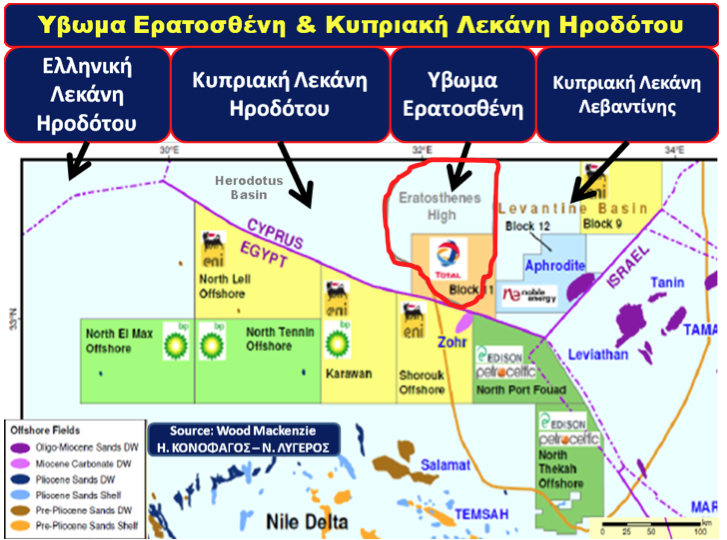24107 - After Eratosthenes, there are new natural gas prospects at the Cypriot Herodotus Basin as well
E, Conophagos, N. Lygeros, A. Foskolos
Translated from the Greek by Athena Kehagias
Just a few days ago we become aware, re: the huge potential of the existence of gigantic reserves around Eratosthenes.
The expected recoverable hydrocarbon resources (90% probability) in those marine fields, are currently estimated at, at least 50 trillion cubic feet (Tcf).
Simultaneously we’ve explained, that the nice surprises within the Northern Levantine Cypriot geological basin, have only just started to occur.
The prospects of recoverable hydrocarbon resources of that particular Basin, are estimated to be containing recoverable amounts (90% probability) in the order of 20 Tcf.
But the capabilities of the Cypriot EEZ do not stop here.
The extremely important perspectives of the existence of natural gas reserves in the Cypriot Basin Herodotus (see. Fig.1), which has similarities with the Levantine Basin, still remain to come to surface.
In this particular field, significant evidence of underwater natural gas fumes have already been found, while simultaneously very large sandstone hydrocarbon targets (structures) have been recorded.
The most substanctial problem of this Basin remains its mere depth, ie, the very deep water depths regarding the reserves varying from 2500-3000 meters.
Despite the relatively low hydrocarbon current prices, the possibility of promoting the mineral wealth of the Herodotus Basin within a short period, will depend on the strategy the Cypriot government will decide upon following, and this at the higher level at that.
The Cypriot government should follow a policy – of promoting the underwater mineral wealth, in very deep waters – similar to the one adopted and used successfully by the USA at the Gulf of Mexico, and likewise by Egypt in the Nile Delta.
It is therefore the obligation of the Cypriot government to promote and develop ASAP the country’s mineral wealth, firstly in relatively shallow areas (depth of <1,700 meters).
This will allow the creation of a first major marine infrastructure re: hydrocarbon production, within the Cypriot EEZ, with the presence of underwater production drilling heads, and hydrocarbon transportation pipelines, towards floating, or stable platforms, and or tankers for the processing of natural gas and crude oil condensates.
The presence of the above mentioned infrastructure will allow – in a future licensing round phase – the oil companies to invest at a much smaller cost, in larger sea depths, with much lower reserve development and production costs, due to the already existing infrastructure facilities within the wider Cypriot EEZ.
As far as the emergence and promotion of the mineral wealth within the Greek region of the Herodotus basin, a similar to Cyprus underwater research policy should be followed, with the promotion of expected hydrocarbon reserves in the relatively shallow marine water fields of Southern Crete as its priority.

